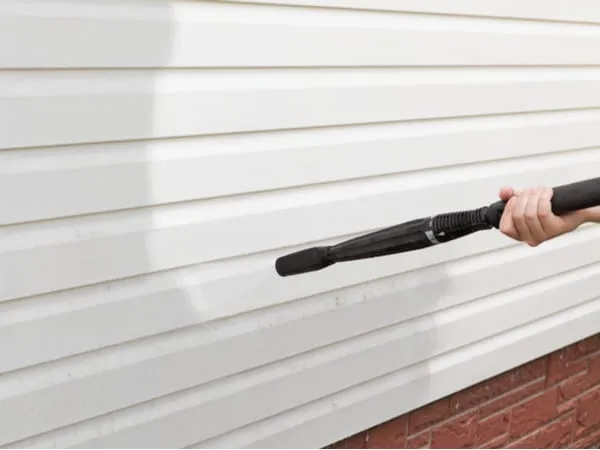Give Your Home a Fresh Coat of Charm with Painted Aluminum Siding
Are you tired of looking at dull, faded aluminum siding?
Or maybe you’ve noticed that oxidation is making your home’s exterior look chalky and worn out?
Painting aluminum siding can be an affordable way to revive its look and add years to its life.
In this guide, we’ll cover everything you need to know, from prepping the siding to selecting the best tools and applying the paint for a flawless finish.
By the end, you’ll have all the tips and techniques needed to complete a professional-quality exterior paint job on your aluminum siding.
Plus, we’ll walk you through essential post-painting maintenance tips to help keep that fresh look for as long as possible.
Why Paint Aluminum Siding?

Painting aluminum siding can do wonders for your home’s exterior.
It not only refreshes the look but also protects the siding from the elements, helping it stand up to Michigan’s seasonal weather changes.
- Restore Appearance: Over time, aluminum siding can fade, oxidize, and develop a chalky, powdery paint pigment. Adding a fresh coat of paint brings back color and vibrancy, boosting your home’s curb appeal.
- Protect Your Investment: Quality paint acts as a protective barrier, shielding your siding from rain, snow, and UV rays. By sealing the aluminum, you prevent corrosion and avoid future issues like flaking paint or peeling paint.
- Cost-Effective Alternative: Rather than replacing aging siding, which can be costly, painting offers an affordable solution. By choosing to paint aluminum siding, you can save money while still achieving a like-new look for your home’s exterior.
Painting aluminum siding allows you to improve your home’s look and longevity without the expense of replacement, making it a smart investment for homeowners in Ann Arbor.
Tools & Materials for Painting Aluminum Siding

Having the right tools and materials is essential for a smooth and effective painting process.
Quality supplies make all the difference in ensuring good paint adhesion and a lasting finish on your aluminum siding.
Tools
The tools you choose will depend on the size of your paint job and the specific needs of your home’s exterior.
- Brushes, Rollers, or Paint Sprayer: A paint sprayer is ideal for even coverage, but rollers and brushes work well for smaller areas and detailed sections.
- Drop Cloths: Use these to cover plants, patios, and driveways, protecting them from spills and splatters.
- Pressure Washer or Abrasive Sponge: For effective surface cleaning, a pressure washer is a quick choice, while an abrasive sponge is helpful for targeted scrubbing.
- Ladder, Gloves, Goggles, and Safety Mask: Essential safety gear to protect yourself from dust, cleaning solution, and paint splatters.
Materials
The right materials ensure lasting results by improving paint adhesion and providing a smooth surface for painting.
- Acrylic Primer for Metal Surfaces: This primer creates a strong base coat that helps paint adhere and last longer on aluminum siding.
- High-Quality Acrylic Exterior Paint: Choose an acrylic paint made for outdoor use. This type of paint holds up best on metal surfaces and resists fading and cracking.
- Trisodium Phosphate (TSP) Cleaner and Bleach: These are ideal for creating a cleaning solutionthat removes dirt, mildew, and oxidation and prepares the siding for primer and paint.
Using these tools and materials helps ensure your aluminum siding is properly prepped and painted, setting the stage for a long-lasting coat of paint and a beautiful finish on your home’s exterior.
Step 1: Inspect and Prepare the Siding
Before you can paint aluminum siding, it’s essential to inspect and prepare the surface properly.
This step prevents issues like flaking paint and ensures that the new coat of paint will adhere well.
Check for Damage and Oxidation
Aluminum siding often develops signs of wear over time.
Inspect the surface carefully to catch potential problems early.
- Signs of Aging: Look for chalkiness, dents, loose panels, and any mildew buildup. Chalking, a powdery residue, is a common sign that your siding needs cleaning and repainting.
- Test for Lead Paint: If your home was built before 1978, check for lead paint using a test kit. If lead is present, consult a licensed professional for safe removal.
Follow the link for more details on how to prep a house for painting.
Safety Precautions
To complete a paint job safely, make sure you use the appropriate safety gear.
- Protective Gear: Wear gloves, goggles, and a mask to avoid exposure to dust and chemicals.
- Safety During Pressure Washing: If using a pressure washer for cleaning, add waterproof boots and ear protection to your safety gear list.
Step 2: Clean the Aluminum Siding

Cleaning your aluminum siding thoroughly is crucial for ensuring good paint adhesion and a smooth finish.
Whether you’re dealing with dirt, mildew, or oxidation, a clean surface allows the paint to bond effectively and last longer.
Choosing a Cleaning Solution
Using the right cleaning solution can make all the difference in preparing your siding for painting.
- TSP and Bleach Mixture: For tough stains and mildew, mix 1 cup of trisodium phosphate (TSP) with 1 cup of bleach in a gallon of water. This solution helps to break down grime and remove oxidation.
- Biodegradable Option: For a gentler clean, mix biodegradable laundry detergent with water. This is a safer option for homes with plants nearby and still removes dirt effectively.
Pressure Washing vs. Manual Cleaning
Depending on the size of the area and the level of dirt buildup, you can choose between pressure washing or manual scrubbing.
- Pressure Washer: If you have a large area to cover, a pressure washer with 1,700 to 2,800 PSI works well. Spray downward to prevent water from seeping behind the siding. For best results, start at the top and work your way down.
- Manual Scrubbing: For smaller spots or extra attention on stubborn areas, use an abrasive sponge or scrub brush. Work in circular motions and rinse with a garden hose for a thorough cleaning.
Removing Oxidation and Mildew
Oxidation and mildew can interfere with paint application, so it’s essential to address these issues before painting.
- Oxidation: This appears as a chalky, powdery residue on aluminum siding. Use a scrub brush on an extension pole to remove as much of this residue as possible, especially if it has built up over time.
- Mildew: For areas affected by mildew, apply a mildew-resistant cleaner, scrub gently, and rinse thoroughly to keep it from returning.
Step 3: Prime the Aluminum Siding
Applying a primer is essential to ensure your paint adheres effectively and lasts for years on aluminum siding.
A good primer helps create a uniform base, especially when dealing with previously oxidized or chalky surfaces.
Choosing the Right Primer
The type of primer you use matters for paint adhesion and durability.
- Acrylic Primer for Metal Surfaces: Use an acrylic primer specifically designed for metal. This type of primer creates a smooth, tacky surface for the paint to adhere to and holds up well on aluminum siding.
- Avoid Oil-Based Primers: Oil-based primers aren’t ideal for aluminum, as they can interfere with the paint’s ability to bond and may cause peeling.
Application Tips
Properly applying primer is as crucial as choosing the right one for long-lasting results.
- Use a Roller for Even Coverage: Rollers make it easier to cover large areas evenly. Start at one end of the siding and work consistently toward the other to prevent uneven layers.
- Allow for Drying Time: Give the primer about 4–5 hours to dry fully. This drying period ensures optimal paint adhesion when you apply the topcoat, preventing issues like peeling or bubbling.
Step 4: Select the Right Paint for Aluminum Siding
The right paint not only enhances the look of your home’s exterior but also helps protect the aluminum siding for years to come.
Choosing high-quality acrylic paint specifically for exterior use will make a noticeable difference in durability.
Why Acrylic Paint is the Best
Acrylic paints are widely recommended for aluminum surfaces, and for good reason.
- Acrylic Exterior Paint: Acrylic paint is known for its superior adhesion and durability on metal surfaces. It resists fading, cracking, and chipping, making it ideal for aluminum siding.
- Avoid Oil-Based Paints: Oil-based paints aren’t compatible with aluminum, as they can cause peeling and don’t flex well with metal’s natural expansion and contraction.
Choosing the Right Finish
Different finishes offer unique benefits, so pick the one that suits your needs best.
- Satin or Semi-Gloss Finish: These finishes, or paint sheens, are ideal for aluminum because they are durable, resist moisture, and hold up well to UV rays. Satin and semi-gloss finishes also provide a subtle sheen without showing imperfections.
Optimal Weather Conditions
Timing your paint job based on weather conditions is important to ensure a smooth, even application.
- Ideal Conditions: Paint on a day with temperatures over 50°F and low humidity. Avoid painting in direct sunlight or rainy weather, as these can cause paint to dry too quickly or not adhere correctly.
Step 5: Apply the Paint on Aluminum Siding
With your aluminum siding fully prepped and primed, it’s time to move on to painting.
Following the right techniques will help you achieve a smooth, professional-looking finish that lasts.
Painting Techniques for a Professional Finish
When it comes to painting aluminum siding, proper technique is key for even coverage and lasting results.
- Top-Down Approach: Start from the top of your house and work downward. This prevents paint drips from spoiling freshly painted areas below.
- Cutting In Edges First: Use a brush to paint around windows, doors, and edges before applying paint to larger areas. This technique ensures that detailed areas are neatly covered.
- Consider an Airless Sprayer: If you’re painting large sections, an airless paint sprayer provides the smoothest and most efficient application. It delivers a uniform coat and minimizes brush or roller marks. View the video above for more details on the advantages of using an airless paint sprayer, the method preferred by the professionals at Tribble Painting Company. You can also view a detailed comparison of spray vs. brush painting methods here.
Applying Multiple Coats
For the best results, plan to apply more than one coat.
This will enhance both durability and appearance.
- Two Thin Coats Recommended: Instead of one thick coat, applying two coats helps prevent drips and uneven spots. Allow the first coat to dry fully before applying the second coat, as this ensures proper adhesion.
- Allow Drying Time Between Coats: Let each coat dry for at least 2–3 hours, or as specified on the paint can, to achieve the most durable finish.
Step 6: Post-Painting Maintenance and Touch-Ups

Maintaining your newly painted aluminum siding will help it look fresh and protect it from environmental wear.
A few routine maintenance steps can keep the paint looking vibrant for years.
Regular Maintenance
Keeping your siding clean will extend the life of the fresh coat of paint and maintain your home’s curb appeal.
- Annual Cleaning: Rinse your siding annually with a garden hose and mild detergent to remove dirt and mildew. This helps preserve the paint’s color and finish.
- Avoid Harsh Chemicals: Steer clear of abrasive cleaners that can strip away paint. Stick with gentle cleaning solutions that won’t damage the new paint.
Touch-Up Tips
Small touch-ups over time can help keep your siding looking pristine.
- Keep Extra Paint on Hand: Store leftover paint for easy touch-ups if any areas start to chip or fade. Having matching paint readily available makes minor repairs simple.
- Spot Treat Small Areas: Use a small brush for touch-ups on chipped sections or scratches. This way, you maintain a consistent look across the siding without needing a full repaint.
Repainting Frequency
Knowing when to repaint helps keep your home’s exterior in peak condition.
- Repaint Every 5–10 Years: Depending on weather exposure, plan to repaint aluminum siding every 5–10 years to maintain its appearance and durability. Regular upkeep can extend this time frame by preserving the integrity of the paint.
Revitalize Your Home’s Curb Appeal with Tribble Painting Company
Painting your aluminum siding is a cost-effective way to refresh your home’s look and extend the life of your siding.
But if tackling this project on your own feels overwhelming, let the experts at Tribble Painting Company take care of it for you.
Our skilled team has the experience and equipment to handle every step, from preparation to the final coat, ensuring a flawless finish and lasting results.
Ready to transform your home’s exterior?
Fill out our contact form today, or give us a call to get started!

